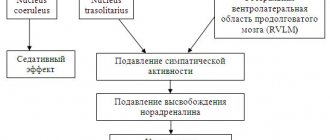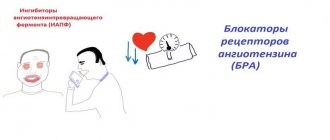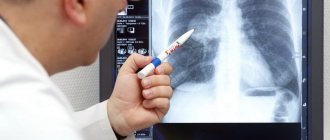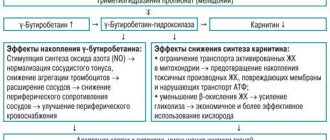Indapamide
Indapamide is a thiazide-like diuretic that also has vasodilatory properties. Used to treat arterial hypertension. Thiazide and thiazide-like diuretics are still at the forefront of antihypertensive therapy. They are used as first-line drugs both in monotherapy and as part of combination treatment, and their inclusion in the pharmacotherapeutic antihypertensive course significantly improves the overall cardiovascular prognosis.
The mechanism of action of indapamide is close to that of thiazides, which is not surprising, because both drug groups are sulfonamide derivatives. The drug acts in the initial sections of the distal tubules, where under normal conditions the reabsorption of 5–10% of sodium and chlorine ions filtered into the primary urine occurs, suppressing this very absorption. Despite ongoing discussions about the advantages and disadvantages of thiazide and thiazide-like diuretics in comparison with each other, thiazide-like drugs have recently come to the fore, supporting their breakthrough with the results of numerous clinical studies. For example, British experts already today recommend giving preference to thiazide-like diuretics when treating patients with arterial hypertension.
Due to some unique properties, indapamide stands out even within its pharmacological subgroup. It has been reliably confirmed that it has a vasodilating effect, which contributes a considerable amount to the overall antihypertensive effect. The vasodilator activity of the drug is due to the normalization of the increased sensitivity of blood vessels to the action of a number of vasopressor factors (norepinephrine, angiotensin II, thromboxane A2) and a decrease in the concentration of free radicals, which occurs incl.
h due to inhibition of peroxidation of “bad” cholesterol. Indapamide also has some calcium channel blocker properties. Another distinctive feature of the drug, which makes it stand out among thiazide and thiazide-like diuretics, is the peculiar separation of its antihypertensive activity and diuretic effect, a clear indication of which is the preservation of the antihypertensive effect at the same level in patients with chronic kidney disease. The lipophilicity (ability to dissolve in fats) of indapamil is an order of magnitude higher than that of other thiazides, which gives it the ability to accumulate in smooth muscle vascular cells.
At the end of the last century, clear requirements for an ideal antihypertensive agent were formulated: the duration of the effect is at least 24 hours (subject to a single dose) and the uniformity of the antihypertensive effect, supported by the absence of significant fluctuations in the concentration of the active substance in the blood. To solve (at least partially) this problem, sustained-release dosage forms of indapamide (so-called retard forms) were developed. The process of its absorption in the digestive tract is essential to ensure the uniformity of the drug's action. The antihypertensive agent should not be absorbed all at once, because in this case, a sharp decrease in blood pressure will occur. The retard form avoids pronounced changes in the concentration of the drug in the blood and instability of the pharmacological effect over time. Indapamide in this release form can be found in pharmacies under the name “indapamide retard”.
A neurologist named common mistakes in the fight against migraine
When people in any country in the world are asked what spoils their health most often, the undisputed leader emerges: headaches. It can begin after vaccination against coronavirus and is painful when contracting covid. Pierces during strokes and torments during brain tumors. However, in the vast majority of cases, there are two types of so-called primary headaches, that is, not associated with other diseases (as opposed to secondary pain, for example, with tumors or vascular accidents). These are tension headaches and migraines. The latter, according to the World Health Organization, affects more than a billion people, or every seventh inhabitant of the Earth. Every September there is a special International Migraine Awareness Week. What scientists and doctors have learned about this scourge recently and what misconceptions about migraine and its treatment are most common today, Margarita Naprienko, the head physician of the Academician Wayne Clinic for Headache and Autonomic Disorders, neurologist, Doctor of Medical Sciences, Professor at Sechenov University, told reporters.
PROBLEM 1: THIS IS NOT A DISEASE “Traditionally, in Soviet times, and I was still in this period, we practically did not treat headaches,” says Professor Naprienko. - On the one hand, there was such a disease, everyone knew it. On the other hand, it was as if it did not exist, because our patients could not receive sick leave. There were common expressions like “Migraine - too lazy to work”, they are still tenacious. And many patients do not come to specialists for precisely this reason. According to epidemiological data, with episodic migraine, which occurs up to eight times a month, only every fourth person consults a doctor. If headaches occur more often, only half, every second, go to specialists.
In fact, migraine, of course, is a full-fledged independent disease, the expert explains. Although, even today this disease remains a mystery for scientists and doctors.
PROBLEM 2: WHERE DOES IT COME FROM - The final theory of the origin of migraine and the development of the attack has not been formed. Great steps have been taken in this direction; some of the processes are clear to specialists, but the mechanism has not yet been fully studied,” says Margarita Naprienko. “We know that there are people with a certain functioning of the brain: they are susceptible to easy arousal under the influence of a variety of provoking factors. Against the background of such provocateurs, certain neurochemical processes in the brain are triggered, during which the levels of various substances change. Among them is serotonin, popularly known as the “pleasure hormone.”
Under the influence of the ongoing processes during migraine, the so-called “cortical spreading depression” develops, the doctor continues. It manifests itself in a decrease in the electrical activity of brain cells. “This wave travels through the brain tissue, causing vasoconstriction, which leads to decreased blood flow to the brain. During this period, people may experience a headache precursor such as an aura (see details below), says the professor. “However, this wave passes quickly enough, and the vessels begin to expand. Inflammation develops in them, blood flows into the inflamed wall of the vessel, and during this period people begin to feel pain.”
With migraine with aura, a cascade of different neurological symptoms is observed before the headache attack.
- These may be changes in vision, sensitivity, speech impairment. But it is very important that these changes are reversible, that is, they can last from five minutes to an hour, and must pass without fail, emphasizes Dr. Naprienko. “When this happens for the first time, patients get very scared, and doctors can’t always figure it out. Such reversible symptoms may be mistaken for acute cerebrovascular accidents (stroke).
PROBLEM 3: THERE IS NO LIFE THREATENING, BUT ITS QUALITY IS RADICALLY DECREASING Migraine is not a life-threatening disease, explains Margarita Naprienko. And because of this, patients often encounter misunderstandings from acquaintances, loved ones, colleagues and employers.
- The person seems to be healthy, his arms and legs are in place, he stands, he can work from the point of view of others. And at the same time he says that he cannot do anything. I am not aware of any cases where employers fired people because of migraines in Russia. But families in which migraine caused serious problems in relationships met at the reception. It was even necessary to write ridiculous certificates stating that the patient might actually be poorly able to work or completely incapacitated for a certain period of time. And, accordingly, during this period they are recommended to have relative peace.
What will happen if you do not engage in special treatment for migraines, endure attacks, and in the case when they are completely unbearable, call an ambulance? This is the approach that most patients practice, the doctor confirms.
- Of course, you can endure it, understanding that the attack will end. But it’s one thing if a person is not burdened with anything, does not work, and has no children requiring supervision. Then, perhaps, he can lie down in a dark room and wait for the torment to pass. But if continuous vomiting and a bursting headache begin, then people call an ambulance. Alas, in fact, it cannot greatly alleviate the condition of migraines, explains Professor Naprienko. — Yes, against the background of severe pain, a person’s blood pressure may jump and panic may begin, then sedatives will be administered to normalize the pressure. But the ambulance does not have the resources to act on the pain attack itself during a migraine.
PROBLEM 4: HOW TO BE TREATED? There are two approaches, the expert says. For episodic migraines (attacks no more than 8 times a month), medications are used to relieve headache attacks. If migraine occurs frequently, then preventive therapy is prescribed - it makes attacks less frequent and reduces pain.
“It is impossible to completely recover from migraine, because it is a genetically determined disease,” explains Margarita Naprienko. “But today it is quite possible to make attacks rare and not severe, which most patients do not know about.
The gold standard for treating a migraine attack is taking aspirin, the professor continues. “Better than effervescent, always in a large dosage, 1,000 mg (pay attention to contraindications! - Ed.). Anti-nausea medications may also be added if present. Very often, during a migraine attack, medications are poorly absorbed in the stomach, and then we prescribe drugs that enhance peristalsis. And we recommend low doses of caffeine. This could be a cup of sweet tea, coffee or even Coca-Cola.
An important point: if a person has a headache, it is extremely undesirable to immediately take a pill, emphasizes Dr. Naprienko. The body has a system to counteract pain and it is quite possible that it will cope without allowing an attack to develop. The same tea, coffee or cola can help. Taking painkillers too often and too quickly can lead to the development of so-called drug-induced headaches, warns a neurologist.
- If an hour has passed and your head still hurts, then you need to take triptans. They were created specifically for the relief of migraine attacks and made a real revolution (the first medicine of this class was registered back in 1991 - Ed.). Just keep in mind that triptans cause vasoconstriction, so they are not recommended for use during a migraine aura (see above) - if a person develops this condition, it is advisable to take aspirin first. Perhaps it will allow you to avoid an attack altogether. If not, then after the aura disappears, a triptan is taken.
PROBLEM 5: ADDITION TO MEDICINES “Triptans, which quickly relieve an attack and return a person to work, have a peculiarity: if used incorrectly, addiction to them can quickly develop,” notes Professor Naprienko. “That’s why we always warn patients: they need to strictly control the amount of medications they take. As soon as the figure exceeds 8 doses per month for triptans and 10-12 for simple analgesics (aspirin, citramone, paracetamol, ibuprofen, etc.), this is a direct indication for contacting a specialist. So that the patient is prescribed adequate therapy and preventive treatment is selected.
If you continue to swallow painkillers in huge doses and in huge quantities, then the aforementioned drug-induced headache develops, and the person ends up in a vicious circle, the doctor explains.
For the treatment of frequent, chronic migraines, botulinum toxin type A drugs are used as a preventive treatment, as well as new generation drugs based on monoclonal antibodies. The latter appeared in our country quite recently, about a year ago, and only a doctor can select and prescribe them.
STAY IN THE KNOW How to recognize a migraine
To make a diagnosis, doctors interview the patient. You can check yourself yourself. Here are the main signs of migraine:
- headache attacks last from 4 to 72 hours and are repeated;
- pain has at least two characteristics from the list: strong, throbbing, one-sided, makes you move less (intensifies with bending over, physical activity);
- there is also at least one of these symptoms: nausea, irritation by light and (or) sounds.
Link to publication: kp.ru





